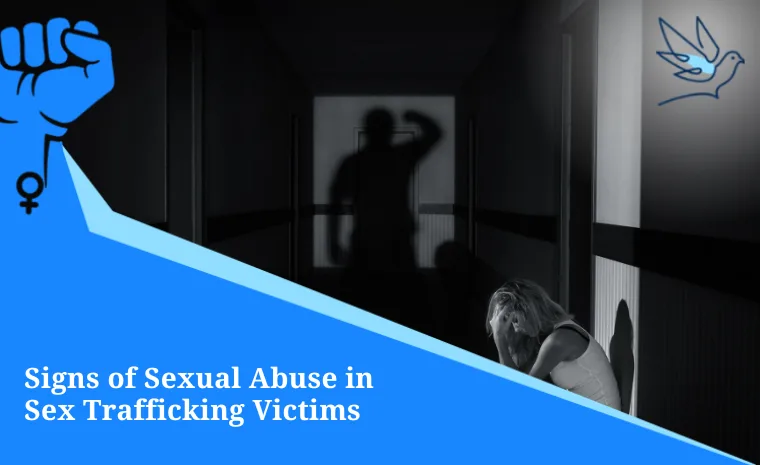Sex trafficking is a pervasive and heinous crime that continues to afflict countless individuals, predominantly women and children, around the world. As advocates for women’s rights, it is a must that we help to shed light on the often silent and insidious aspect of sexual abuse that accompanies the grim reality of sex trafficking. The covert nature of this criminal enterprise makes it challenging to identify and assist victims, necessitating a comprehensive understanding of the signs that may indicate sexual abuse in those ensnared by traffickers.
According to the International Labour Organization (ILO), an estimated 49.6 million people are trapped in slave conditions globally, with 6.3 million of them exploited in the commercial sex industry. This staggering statistic underscores the urgent need for awareness, vigilance, and legal action to combat the exploitation that underlies the sex trafficking trade.
As we discuss the signs of sexual abuse within the context of sex trafficking, it is crucial to recognize the gravity of the issue and the profound impact it has on the lives of victims, who often suffer in silence. By understanding and recognizing these sexual abuse signs, we empower ourselves to advocate for the rights and well-being of those who have been thrust into the shadows of this pervasive and deeply entrenched crime. In particular, we will explore:
- The definition of sex trafficking in California
- The interconnection between sexual abuse and sex trafficking
- Signs of sexual abuse and sex trafficking to be aware of
- What to do if you recognize a case of sexual abuse and sex trafficking
The Definition of Sex Trafficking in California
Sex trafficking is a form of modern-day slavery involving the recruitment, harboring, transportation, provision, or obtaining of a person through force, fraud, or coercion for the purpose of commercial sex exploitation. It is a grave violation of human rights, perpetuating the exploitation and victimization of individuals, predominantly women and children.
The scope of sex trafficking is far-reaching, with victims subjected to countless abuses including physical violence, sexual assault, manipulation, and psychological coercion. Perpetrators exploit vulnerabilities, often preying on socio-economic disadvantages, homelessness, or systemic inequalities. The traffickers, who can be individuals or organized criminal networks, profit from the commodification of human beings in the commercial sex industry.
In California, the impact of sex trafficking is significant due to its diverse population, major urban centers, and proximity to international borders. The state’s role as a major transit and destination point for trafficking activities is influenced by its expansive economy and cultural diversity. According to the California Department of Justice, the state consistently ranks among the highest in the United States for reported cases of human trafficking. Cities such as Los Angeles, San Francisco, and San Diego are identified as hotspots, with their bustling ports, international airports, and vast entertainment industries, providing ample opportunities for traffickers to exploit victims.
The local impact is multifaceted, affecting the physical, emotional, and mental well-being of survivors. The intersectionality of issues such as homelessness, substance abuse, and immigration status further compounds the vulnerability of individuals to exploitation.
Recognizing the local impact of sex trafficking in California is crucial for developing targeted interventions, support systems, and legal measures to address the root causes and protect the rights of victims within the state. Efforts by law enforcement, non-governmental organizations, and advocacy groups play a vital role in raising awareness, providing resources, and dismantling the networks that perpetuate this egregious crime within California’s borders.
The Connection Between Sexual Abuse and Sex Trafficking
The relationship between sexual abuse and sex trafficking is profound, as sex trafficking inherently involves the exploitation of individuals through various forms of sexual coercion and violence. Understanding how exploitation happens within sex trafficking, as well as sexual abuse signs, requires an exploration of manipulation, control, and the severe psychological impact these tactics have on victims.
Once a victim is ensnared, manipulation becomes a powerful tool used to maintain control. Traffickers employ psychological tactics such as isolation, threats to loved ones, and instilling a profound sense of fear to break down the victim’s resistance. Victims are frequently manipulated into believing that escape is impossible, fostering a sense of dependency on the trafficker for survival. Control is often exerted through physical, emotional, and economic means.
Many victims are subjected to physical violence, confinement, or forced substance abuse as a means of control. Emotional manipulation takes the form of constant degradation, manipulation of affection, and the fostering of a sense of hopelessness. Economically, victims are often forced into debt bondage, with traffickers exploiting their financial dependency to perpetuate the abuse.
The psychological impact on victims of sex trafficking is devastating and multifaceted. Many survivors experience trauma bonding, a phenomenon where victims develop a warped sense of loyalty or attachment to their traffickers as a survival mechanism. Post-traumatic stress disorder (PTSD), anxiety, depression, and a range of psychological disorders are common among survivors, stemming from the relentless abuse and degradation they endure.
Furthermore, the commodification of the victim’s body in the commercial sex industry contributes to a dehumanizing experience, eroding self-esteem and fostering a sense of worthlessness. Victims often struggle with shame, guilt, and a distorted self-perception long after escaping their traffickers. Rebuilding a sense of agency, self-worth, and trust in others is a complex and ongoing process for survivors of sex trafficking.
Addressing this interconnection requires a comprehensive approach, encompassing both prevention and support for survivors. Legal measures, social services, and awareness campaigns play critical roles in dismantling trafficking networks, prosecuting perpetrators, and providing survivors with the resources they need to rebuild their lives. Additionally, understanding the psychological toll of exploitation is essential for tailoring trauma-informed care and support that acknowledges the unique challenges faced by survivors of sex trafficking.

Signs of Sexual Abuse and Sex Trafficking to be Aware Of
Recognizing the sexual abuse signs is crucial for identifying and assisting those who may be trapped in exploitative situations. These signs can manifest in various ways, encompassing physical, behavioral, emotional, and psychological indicators.
Physical Signs
- Injuries and Bruises: Unexplained bruises, injuries, or signs of physical trauma may be indicative of physical abuse and violence suffered at the hands of traffickers.
- Sexually Transmitted Infections (STIs): Victims of sex trafficking may be at higher risk of contracting STIs or urinary tract infections due to unprotected sexual activity imposed upon them by traffickers.
- Malnutrition and Dehydration: Forced labor, restricted access to food, or poor living conditions may result in malnutrition and dehydration among victims.
Behavioral Signs
- Fear and Anxiety: Constant fear, anxiety, or signs of extreme nervousness may indicate the victim’s experience of ongoing threats, intimidation, or coercion.
- Isolation: Outside sexual contact and violence, victims are often kept isolated from the outside world, with limited social interactions. This isolation is both a means of control and a way to prevent disclosure.
- Restricted Freedom of Movement: Victims may show signs of being monitored or controlled, with limited ability to move freely or make personal decisions.
- Substance Abuse: Signs of drug abuse or alcohol abuse are common among victims as a coping mechanism, or as a means of control by their traffickers.
Emotional Signs
- Depression and Withdrawal: Victims may exhibit symptoms of depression, withdrawal from social activities, or a pervasive sense of hopelessness.
- Emotional Detachment: Due to repeated trauma and exploitation, victims might display emotional detachment as a coping mechanism to distance themselves from the pain of their experiences.
- Self-Harm or Suicidal Thoughts: The profound psychological impact of sex trafficking may lead to self-destructive aggressive behaviors or thoughts of suicide.
Psychological Signs
- Trauma Bonding: A regressive behavior where the victims may develop a strong emotional connection to their traffickers as a survival strategy, making it challenging for them to break free from the exploitative relationship.
- Disassociation: A coping mechanism to endure the trauma of sexual assault and abuse, victims may disassociate from their own emotions, thoughts, or surroundings.
- Post-Traumatic Stress Disorder (PTSD): Many survivors of sex trafficking experience symptoms of PTSD, including flashbacks, nightmares, repulsion to physical contact, and hypervigilance.
Recognizing these signs requires a multidisciplinary approach involving law enforcement, healthcare professionals, social workers, and the community. Training individuals in these sectors to identify sexual abuse signs in sex trafficking victims is crucial for early intervention and providing the necessary support to help survivors break free from the cycle of exploitation. Additionally, public awareness campaigns can contribute to a more vigilant society, fostering a collective effort to combat sex trafficking and protect vulnerable individuals.
What to Do if You Recognize a Case of Sexual Abuse and Sex Trafficking
If you recognize a case of sexual abuse, it is crucial to take immediate action to ensure the safety and well-being of the victim, as well as your own. Here are the steps you can take:
- Ensure Your Safety: If you suspect someone is suffering sexual abuse and sex trafficking, DO NOT INTERVENE DIRECTLY. Consult with a lawyer as soon as possible and follow their advice to the letter.
- Report to Authorities: With the support of a lawyer, report the case to law enforcement. Provide them with as much information as possible about the incident and the individuals involved. If the abuse occurred online, report it to the appropriate online platform as well.
- Encourage the Victim to Seek Help: If the victim has physical injuries, encourage them to seek medical attention, which can provide evidence of abuse and address any immediate health concerns. Recommend an attorney as well, who will have the resources or expertise to build their case and seek compensation for their damages.
- Support the Victim: Be supportive and empathetic. Encourage the victim to speak about their experience but do not press them if they are not ready. Let them know that you believe and support them.
- Document the Incident: If you have any information about the incident, document it. Write down what you observed, including dates, times, locations, and the people involved. This information may be useful for law enforcement or legal professionals involved in the case.
- Maintain Confidentiality: Respect the victim’s privacy and maintain confidentiality. Do not discuss the details of the case with others unless required by law or an attorney, or when reporting to authorities.
- Know the Reporting Laws in Your Area: Familiarize yourself with the reporting laws in your jurisdiction. In some places, certain professionals, such as teachers and healthcare providers, are mandatory reporters and must report suspected abuse.
- Follow-up: Stay informed about the progress of the investigation if possible. Follow up with the appropriate authorities to ensure that the case is being handled appropriately. If you find it appropriate, suggest that the victim seek professional counseling or therapy for their emotional abuse. Support groups and organizations, such as RAINN (Rape, Abuse & Incest National Network) and Women’s Rights Group can provide resources and support.
Remember that it is essential to involve legal experts and the authorities to address to ensure the well-being and safety of the victim. Sexual abuse and sex trafficking cases are immensely complicated, and you run unnecessary risks and dangers if you choose to not contact professionals to help the victim.
Making the Victim’s Voice Heard
The pervasive and insidious nature of sex trafficking demands a comprehensive understanding of the sexual abuse that often accompanies this terrible crime. As advocates for women’s rights, we recognize the gravity of the issue and its profound impact on victims, and we are ready to help the moment you contact us.
Understanding the interconnection between sexual abuse and sex trafficking, particularly the psychological toll on survivors, emphasizes the need for a multifaceted approach involving legal measures, social services, and awareness campaigns. Recognizing the signs of sexual abuse in sex trafficking victims is crucial for early intervention and support. If one identifies a case, immediate action that is guided by legal professionals is necessary to ensure the safety and well-being of the victim.
However, through collective awareness, vigilance, and collaboration across various sectors, we can strive to combat sex trafficking, protect vulnerable individuals, and dismantle the networks that perpetuate this egregious crime. This is a responsibility for the whole community, and together we can make California a safer place for us.






